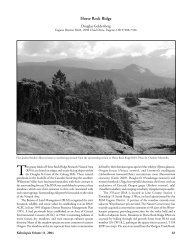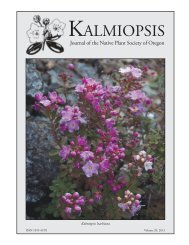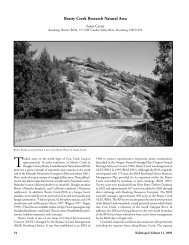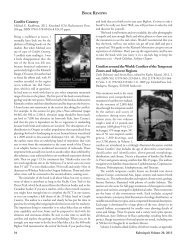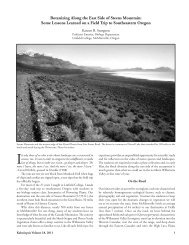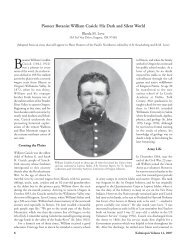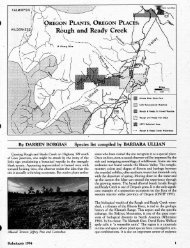Dangly Fen Sedge - Native Plant Society of Oregon
Dangly Fen Sedge - Native Plant Society of Oregon
Dangly Fen Sedge - Native Plant Society of Oregon
Create successful ePaper yourself
Turn your PDF publications into a flip-book with our unique Google optimized e-Paper software.
<strong>Plant</strong> <strong>of</strong> the Year<br />
cutest Carex in <strong>Oregon</strong>” is Carex limosa, according<br />
to many botanists. In the recent Field Guide to <strong>Sedge</strong>s<br />
“The<br />
<strong>of</strong> the Pacifi c Northwest, the authors noted that “mud<br />
sedge is too mundane a name for this graceful little fen dweller”<br />
(Wilson et al. 2008). Not only does it grow primarily in “nonmuddy”<br />
wetlands, it also has much more aesthetic appeal than<br />
“mud.” I suggest a common name that refl ects both its appearance<br />
and its habitat (see sidebar): dangly fen sedge. Of course, some<br />
readers will smile at the combination <strong>of</strong> “dangly fen,” but when<br />
they encounter living plants, they will see that the spikelets <strong>of</strong><br />
this sedge dangle from long slender stems and shake gently in<br />
the breeze. Th is trait is not obvious in herbarium specimens and<br />
drawings or photos <strong>of</strong> pressed plants, which <strong>of</strong>ten give a false<br />
impression that spikelets are erect or stationary.<br />
<strong>Dangly</strong> <strong>Fen</strong> <strong>Sedge</strong> (Carex limosa L.)<br />
Bruce Newhouse<br />
2525 Potter St., Eugene, OR 97405<br />
<strong>Dangly</strong> fen sedge at Bunchgrass Meadow, Washington. Photo by Bruce Newhouse.<br />
Range and Rarity<br />
<strong>Dangly</strong> fen sedge has a circumpolar distribution in the northern<br />
hemisphere, occurring in northern Europe, all <strong>of</strong> Canada and<br />
approximately the northern half <strong>of</strong> the US, extending south into<br />
the mountains <strong>of</strong> California and New Mexico. In <strong>Oregon</strong>, Carex<br />
limosa grows along the spine <strong>of</strong> the Cascade Mountains from<br />
Multnomah County south to Jackson and Klamath counties,<br />
plus two sites in the mountains <strong>of</strong> northeastern <strong>Oregon</strong> (Elkhorn<br />
and Wallowa mountains). Eighteen voucher specimens have been<br />
collected from about ten sites in <strong>Oregon</strong>, with another 16 observed<br />
locations (occasionally photographed). Most <strong>of</strong> the collections are<br />
in the OSU herbarium, except for a few in agency and community<br />
college herbaria. Th e herbarium at the University <strong>of</strong> Washington<br />
Kalmiopsis Volume 16, 2009 15
An 1877 Dutch illustration shows the stolons and other features <strong>of</strong> dangly fen<br />
sedge. Illustration from http://caliban.mpiz-koeln.mpg.de/~stueber/batava/<br />
band17/high/IMG_9539.html<br />
(WTU) houses 22 specimens from ten Washington counties.<br />
Most were collected from the Cascade Range, but a few are from<br />
mountainous northeastern Washington.<br />
Th e University <strong>of</strong> California’s Jepson Interchange website<br />
(Jepson Online Interchange 2008) indicates that Carex limosa<br />
has been found in California primarily in the high Sierra Nevada<br />
Mountain region, with two sites in the North Central region,<br />
for a total <strong>of</strong> 46 vouchers in 8 counties. It is rated S3 for rarity<br />
in California, indicating an extent <strong>of</strong> “21-80 occurrences or<br />
3,000-10,000 individuals or 10,000-50,000 acres” (CNPS 2009).<br />
Because it occurs fairly regularly throughout its worldwide, boreal<br />
range, the global status <strong>of</strong> dangly fen sedge is secure, and in<br />
North America, it is rare only at the southern limits <strong>of</strong> its range<br />
(NatureServe 2009). <strong>Dangly</strong> fen sedge is not a rare species in<br />
<strong>Oregon</strong> and Washington.<br />
Carex limosa locations in <strong>Oregon</strong><br />
(specimens at OSC and observation locations, summarized<br />
from <strong>Oregon</strong> Flora Project 2009)<br />
Clackamas County<br />
Near Government Camp (1916, OSC)<br />
Dinger Lake, Mt. Hood NF (1993 obs.)<br />
Deschutes County<br />
Southern mire <strong>of</strong> three main mires at Little Cultus Lake (1985,<br />
1993 OSC)<br />
Jackson County<br />
Swamp (1902 OSC)<br />
Klamath County<br />
Swamps along west boundary, Crater Lake National<br />
Park (1928 OSC)<br />
28 mi. NW <strong>of</strong> Klamath Falls (1979 OSC)<br />
Tunnel Creek Wetland (2001 obs.)<br />
Lane County<br />
Gold Lake Bog (1926, 1977 OSC; 1989 obs.)<br />
Quaking Aspen Bog, Quaking Aspen Swamp (1979,<br />
1984 OSC; 1999 obs.)<br />
Hidden and Lulu Lakes (1992 obs.)<br />
Cedar Swamp and meadows to north and west (2005 obs.)<br />
Skookum Creek Swamp (2001 obs.)<br />
Meadows at headwaters <strong>of</strong> French Pete Creek (2005 obs.)<br />
Meadow southwest <strong>of</strong> Blue Lake (2005 obs.)<br />
Shroy Meadow, Mink Lake Basin: Shroy, West Porky<br />
and Cliff Lake meadows, Cow Swamp (2006 obs.)<br />
Linn County<br />
Bog 100 yards south <strong>of</strong> Jct. <strong>of</strong> Hwy 22 and USFS Rd.<br />
2067 (1996 OSC)<br />
Hwy 22 & USFS Rd. 2067 (1996 obs.)<br />
Meadow on east side <strong>of</strong> Jack Creek, south <strong>of</strong> Marion<br />
Lake (2005 obs.)<br />
Multnomah County<br />
Vicinity <strong>of</strong> LaTourelle Prairie (1996 obs.)<br />
Union County<br />
Headwaters <strong>of</strong> the Grand Ronde River (2001 OSC)<br />
Wallowa County<br />
Bog at Duck Lake (1991, 1999 OSC)<br />
Wasco County<br />
Trapper Meadow (1995 obs.)<br />
Relatives and Look-alikes<br />
<strong>Dangly</strong> fen sedge belongs to a small section <strong>of</strong> the genus Carex<br />
(Section Limosae) whose members <strong>of</strong>ten have yellow felt-like hairs<br />
on young roots (Hitchcock and Cronquist 1973, Mastroguiseppe<br />
Th e range map from the PLANTS web site shows the primarily boreal<br />
distribution <strong>of</strong> Carex limosa in North America.<br />
16 Kalmiopsis Volume 16, 2009
Limos and Common Names<br />
Th e Latin word limos in the specifi c epithet means “slimy”<br />
or “muddy.” Linnaeus, who named Carex limosa in 1753 in<br />
Species <strong>Plant</strong>arum, was probably referring to wet habitats in<br />
northern Europe where this species was fi rst described. In the<br />
western US, its habitats are peaty fens and bogs (sometimes<br />
fl oating bogs), rather than “slimy, muddy” places. German web<br />
sites generally list the species as “schlamm segge” (mud sedge),<br />
and a Danish site lists “mudder rietgrass” and two English<br />
common names: “mud carex” and “green and gold carex.”<br />
In the Flora <strong>of</strong> North America, Ball and Reznicek (2002)<br />
include a French name, “carex des bourbiers,” which translates<br />
to “mire sedge 1 .” Peck (1961) and Janeway (1992) used the<br />
name “shore sedge;” both “mud” and “shore” are common<br />
names listed by Hurd et al. (1998) and the Washington Flora<br />
Checklist (Burke Museum 2009). Hipp and others (2008) call<br />
it “muck sedge” in the Field Guide to Wisconsin <strong>Sedge</strong>s. In the<br />
UK, Carex limosa is known as “bog sedge” or “common bog<br />
sedge.” Th e common name dangly fen sedge is my invention;<br />
it has not been published anywhere else.<br />
More About Limosa<br />
Linnaeus also used “Limosa” to designate the genus <strong>of</strong> godwits,<br />
a group <strong>of</strong> tall, lanky shorebirds with very long bills. Th ese bills,<br />
slightly upturned at the end, are an adaptation for probing in<br />
mud to feed on subsurface invertebrates. One Eurasian species,<br />
the Black-tailed Godwit, is named Limosa limosa 2 . (Perhaps a<br />
direct translation would be the “slimy-slimy?”)<br />
Black-tailed godwit (Limosa limosa). Photo by Marek Szczepanek.<br />
1 Bourbiers can also be translated as bog, slough, quagmire, morass<br />
or plight.<br />
2 Tautonyms (in which the specifi c epithet is the same as the generic<br />
name) may be applied to animals, but are not allowed in botanical<br />
nomenclature.<br />
1993), and whose fl ower spikes, borne on long peduncles, <strong>of</strong>ten<br />
dangle. All modern references consulted for this article consider<br />
Carex limosa L. as one taxonomic entity, with no subspecies or<br />
varieties currently recognized. At the terminus <strong>of</strong> the Carex limosa<br />
infl orescence is an all-male spikelet, skinny and nondescript. Th e<br />
lower spikelets (usually two to four) are female, sometimes with<br />
male fl owers at the tips. Th ese lower spikelets dangle on long<br />
peduncles at maturity.<br />
Within Section Limosae, dangly fen sedge’s two closest relatives<br />
in <strong>Oregon</strong> are long-awn sedge (Carex macrochaeta) and black bog<br />
sedge (C. plurifl ora). Both are considered rare and are restricted<br />
to the northwestern part <strong>of</strong> the state. Th e Field Guide to <strong>Sedge</strong>s <strong>of</strong><br />
the Pacifi c Northwest tells how to distinguish these three species<br />
in <strong>Oregon</strong>, including morphological characters, as well as range<br />
and habitat diff erences. Long-awn sedge grows primarily on moist<br />
cliff s in the vicinity <strong>of</strong> the Columbia Gorge, while black bog sedge,<br />
with its distinctive black perigynia, is currently known from only<br />
one wetland near Seaside. In the Pacifi c Northwest, the species<br />
that most closely resembles dangly fen sedge is black bog sedge<br />
(Carex magellanica ssp. irrigua). It is a Rocky Mountain species<br />
that occurs as far west as northern Washington and it is highly<br />
unlikely that this species would be found in <strong>Oregon</strong>. <strong>Dangly</strong> fen<br />
sedge and black bog sedge have been known to hybridize where<br />
their ranges overlap (Gage and Cooper 2006).<br />
<strong>Dangly</strong> fen sedge also superfi cially resembles two “dangly”<br />
grasses, big quaking grass (Briza maxima) and rattlesnake brome<br />
(Bromus brizaeformis), but luckily for the beginning botanist,<br />
grasses diff er greatly in their reproductive structure. Additionally,<br />
these two grasses grow in human-disturbed habitats at low<br />
elevations, not montane wetlands.<br />
If you fi nd a sedge in the Cascade or Wallowa mountains <strong>of</strong><br />
northern <strong>Oregon</strong> that you think is dangly fen sedge, use a key<br />
that includes look-alike species with overlapping ranges (e.g.,<br />
Field Guide to the <strong>Sedge</strong>s <strong>of</strong> the Pacifi c Northwest). If it is a “new”<br />
location (a site not shown on the distribution map), the population<br />
contains more than 20 individuals, and you have the landowner’s<br />
permission, collect a specimen for the OSU herbarium (and<br />
possibly another for a second, nearby herbarium). Such collections<br />
allow taxonomists now and in the future to closely examine<br />
material for an accurate assessment. Otherwise, take photographs<br />
and document the location.<br />
Biology and Ecology<br />
<strong>Dangly</strong> fen sedge is stoloniferous (unusual in the genus Carex), but<br />
is sometimes described as having rhizomes (lateral below-ground<br />
stems) because the stolons (lateral above-ground stems) may be<br />
shallowly embedded in the very wet substrate in which it grows.<br />
Slender tufts <strong>of</strong> stems and thin leaves with incurved margins usually<br />
are spaced widely apart along the stolons. Montane wetlands tend<br />
to be nutrient-poor, setting the stage for intense competition<br />
among plants in the communities. Along the stolons, dangly fen<br />
sedge has occasional “sinker” roots that penetrate deep into the<br />
substrate and enable it to take up the nutrients more effi ciently than<br />
many <strong>of</strong> its taller competitors (Wilson et al. 2008). Th e fi ne tufts <strong>of</strong><br />
delicate leaves and a tendency to mix with other vegetation make<br />
dangly fen sedge diffi cult to spot. Once, Washington caricologist<br />
(sedge expert) Fred Weinman overlooked this species the fi rst time<br />
Kalmiopsis Volume 16, 2009 17
he visited a particular site, and found it only by returning to search<br />
for it a second time!<br />
<strong>Dangly</strong> fen sedge is a species <strong>of</strong> mountain wetlands. Collection<br />
sites in <strong>Oregon</strong> range from 3,000 to 5,500 feet, and in California<br />
up to about 6,600 feet in the Sierra Nevada Mountains. Collectors<br />
<strong>of</strong> dangly fen sedge in <strong>Oregon</strong>, Washington, and California<br />
described its habitat as sunny, wet sites, using a variety <strong>of</strong> terms:<br />
bog, mire, swamp, wet peaty sedge meadow, sphagnum bog,<br />
soggy Darlingtonia meadow. I have seen the species in about ten<br />
locations in the central Cascades <strong>of</strong> <strong>Oregon</strong>, where it grows with<br />
peat mosses and with other wet-site sedges and forbs. Occasionally,<br />
I found it in more open, muddy habitats. I learned to approach it<br />
cautiously in fl oating mat habitats after punching a foot (or more!)<br />
through to cold lake water. In the Rocky Mountains, dangly fen<br />
sedge occurs also primarily in fens, and in a wide range <strong>of</strong> pH and<br />
nutrient conditions (Gage and Cooper 2006).<br />
Associated species in <strong>Oregon</strong><br />
<strong>Dangly</strong> fen sedge <strong>of</strong>ten mingles with other sedges, including water<br />
sedge (Carex aquatilis), silvery sedge (C. canescens), star sedge (C.<br />
echinata) and southern beaked sedge (C. utriculata), and with a<br />
number <strong>of</strong> montane wetland plants, e.g., peat mosses (Sphagnum<br />
spp.), spikerushes (Eleocharis spp.), cottongrasses (Eriophorum spp.),<br />
marsh or purple cinquefoil (Comarum palustre) and English or<br />
If you look very closely, you might fi nd dangly fen sedge in this type <strong>of</strong> habitat, Blue Lake, Lane County,<br />
<strong>Oregon</strong>. Photo by Bruce Newhouse.<br />
Distribution <strong>of</strong> Carex limosa in <strong>Oregon</strong>. Map courtesy <strong>of</strong> <strong>Oregon</strong> Atlas<br />
Project, www.oregonfl ora.org/atlas.php<br />
line-leaved sundew (Drosera anglica). Other common associates are<br />
Baltic rush (Juncus balticus), marsh buckbean (Menyanthes trifoliata),<br />
podgrass or American scheuchzeria (Scheuchzeria palustris), willows<br />
(Salix spp.), alders (Alnus spp.), alpine<br />
shooting star (Dodecatheon alpinum),<br />
Gorman’s buttercup (Ranunculus<br />
gormanii), elephant’s head pedicularis<br />
(Pedicularis groenlandica), and lodgepole<br />
pine (Pinus contorta var. latifolia)<br />
is <strong>of</strong>ten nearby. A collection label from<br />
Gold Lake Bog (Lane County) listed a<br />
moss (Drepanocladus vernicosus).<br />
In <strong>Oregon</strong>, other species that share<br />
dangly fen sedge’s montane wetland<br />
habitats are Roosevelt elk, black bear,<br />
sandhill crane, a small damselfl y called<br />
sedge sprite (Nehalennia irene), and<br />
a small butterfl y called dun skipper<br />
(Euphyes vestris). Th e skipper lays its<br />
eggs on sedges, where its larvae feed.<br />
Conservation<br />
Because dangly fen sedge grows in<br />
wetlands on public land above 3,000 ft.<br />
in <strong>Oregon</strong>, land management practices<br />
generally do not jeopardize populations<br />
here. Potential exceptions include<br />
grazing, long-term plant succession<br />
and climate change. Large ungulates<br />
graze sedges and other graminoids,<br />
and elk occasionally create wallows in<br />
wet areas. (Over-hunting <strong>of</strong> mountain<br />
lions, the primary natural predator <strong>of</strong><br />
elk, could result in larger populations<br />
and potentially affect vegetation<br />
18 Kalmiopsis Volume 16, 2009
An elusive sandhill crane left tracks in the mud between sedges at Cow Swamp<br />
in Lane County. Photo by Bruce Newhouse.<br />
similar to documented trophic cascade eff ects in other ecosystems;<br />
e,g., Ripple and Beschta 2003.) Fortunately, some populations <strong>of</strong><br />
dangly fen sedge in <strong>Oregon</strong> grow on fl oating Sphagnum mats, which<br />
presently are too wet for ungulate use. In long-term succession, fens<br />
and bogs tend to fi ll in with soil and denser, woody vegetation,<br />
making habitat less favorable for dangly fen sedge and other<br />
herbaceous plants. With climate change, one could speculate that<br />
higher temperatures and changes in precipitation could eventually<br />
alter the range <strong>of</strong> the species. But for now, too many unknowns<br />
limit meaningful prediction.<br />
Final thoughts<br />
Th e best time to look for dangly fen sedge in montane <strong>Oregon</strong><br />
depends somewhat on weather, particularly, how much snow has<br />
fallen during the previous winter and how long it lingers at higher<br />
elevations. In general, from early July (mid-elevations) through<br />
mid-September (high elevations) is the best time to fi nd mature<br />
plants. Like nearly all sedges, it is more easily identifi ed when its<br />
fruits (perigynia) are fully mature.<br />
<strong>Dangly</strong> fen sedge is a delicate little plant that will reward you<br />
– if you are lucky enough to fi nd it – with its subtle beauty during<br />
your light-footed treks through montane wetlands. While you are<br />
botanically fascinated by a fen, perhaps a sandhill crane will startle<br />
you as it takes <strong>of</strong>f from behind a willow copse across the way, and<br />
as your heart slows to normal, you may notice something down at<br />
your feet. Voilá! As you smile and drop gently onto your knees, there<br />
it will be with its dangling spikelets dancing a bit in the breeze.<br />
Acknowledgements<br />
Eminent botanist Peter Zika fostered my initial attraction to<br />
graminoids. Peter showed me how interesting it could be look close<br />
and study the tremendous plant diversity in the smallest plants<br />
around and under my feet. Over the ensuing years, the Carex<br />
Working Group (Dick Brainerd, Nick Otting and Barbara Wilson)<br />
furthered that appreciation. I now fi nd sedges to be “familiar old<br />
friends” when I travel in the Northwest and beyond (despite my<br />
trouble with that challenging Section, Ovales). I extend special<br />
thanks to Th ea Cook <strong>of</strong> the <strong>Oregon</strong> Flora Project (Atlas), Barbara<br />
Wilson for initial editing, and Dana Visalli, Nick Otting, Fred<br />
Weinman, Barbara Wilson and Peter Zika, for responding to my<br />
request for information.<br />
References<br />
Ball PW, Reznicek AA. 2002. Carex. pp. 254-572 in Flora <strong>of</strong> North<br />
America Editorial Committee, eds., Flora <strong>of</strong> North America<br />
North <strong>of</strong> Mexico, Volume 23: Magnoliophyta: Commelinidae (in<br />
part): Cyperaceae. New York (NY): Oxford University Press.<br />
Burke Museum <strong>of</strong> Natural History and Culture. 2009. County<br />
distribution maps for Washington State plants (online edition).<br />
Seattle (WA): University <strong>of</strong> Washington. http://biology.burke.<br />
washington.edu/herbarium/resources/wtucountyquery.php<br />
Accessed April 2, 2009.<br />
California <strong>Native</strong> <strong>Plant</strong> <strong>Society</strong> (CNPS). 2009. Inventory <strong>of</strong> Rare<br />
and Endangered <strong>Plant</strong>s (online, v7-09a). http://www.cnps.org/<br />
inventory Accessed April 2, 2009.<br />
<strong>Dangly</strong> fen sedge occasionally grows in patches, as seen here at Swamp Lake,<br />
Washington. Photo by Bruce Newhouse.<br />
Kalmiopsis Volume 16, 2009 19
Wetlands: Bogs, <strong>Fen</strong>s and Poor <strong>Fen</strong>s 1<br />
Although fen, poor fen and bog have been defi ned in many<br />
diff erent ways throughout the world, the terms here follow<br />
defi nitions in the recent US Environmental Protection<br />
Agency publication EPA 843-F-01-002b, Types <strong>of</strong> Wetlands,<br />
March 2002, available on line at http://www.epa.gov/<br />
owow/wetlands/facts/types_pr.pdf. Whether the water, soil<br />
or substrate is acidic or alkaline greatly infl uences which<br />
plant species thrive in a given wetland. A fen is a wetland in<br />
which the water is alkaline to only slightly acid and has been<br />
in contact with mineral soil; the substrate is accumulated<br />
organic material derived primarily from graminoids (grasses,<br />
sedges, rushes) and bryophytes other than sphagnum. <strong>Fen</strong>s<br />
may be fl at or sloping, including relatively steep slopes. A bog<br />
is a wetland in which the water is acidic and comes only from<br />
precipitation, which is relatively mineral-poor compared<br />
to groundwater; the substrate is accumulated organic<br />
material derived primarily from sphagnum, graminoids,<br />
and ericaceous shrubs. Bogs may be fl at or sloping and<br />
are characterized by a sphagnum peat layer that lifts the<br />
vegetation above contact with mineral-rich ground water.<br />
In <strong>Oregon</strong>, there are apparently no true bogs, and the acidic<br />
wetlands with sphagnum are classifi ed as poor fens. Th e<br />
modifi er comes from the relatively poor nutrient levels and<br />
acidic conditions. Peat refers to the amorphous or partially<br />
decomposed organic remains <strong>of</strong> plant materials found in a<br />
bog, fen, or other wetland. Peat found in bogs derives from<br />
sphagnum, so it is acidic and has special characteristics related<br />
to the antiseptic properties <strong>of</strong> the moss. It is <strong>of</strong>ten used as an<br />
additive to make garden soils more acidic and increase organic<br />
content. Peat formed from graminoid organic matter may<br />
not be acidic. –Frank Lang and John Christy<br />
1 Adapted from sidebar in Kalmiopsis 11:31.<br />
About <strong>Sedge</strong>s<br />
Carex is the largest genus in its family, Cyperaceae, and one<br />
<strong>of</strong> the largest plant genera in the world. In a fi eld guide<br />
to <strong>Oregon</strong> and Washington sedges, Wilson et al. (2008)<br />
noted that Linnaeus used the classic Latin name, Carex,<br />
for the genus; the Latin word means “cutter,” in reference<br />
to knife-like leaf edges. Another recent, in-depth treatment<br />
<strong>of</strong> the genus can be found in the Cyperaceae section <strong>of</strong> the<br />
Flora <strong>of</strong> North America (Ball and Reznicek 2002).<br />
<strong>Sedge</strong>s are wind-pollinated monocots that produce<br />
achenes. In Carex, the achene is contained within a membranous<br />
bract (perigynium) that is open only at the tip. Th e<br />
mature perigynia fall, or are easily knocked loose from their<br />
spikelets and disseminated by water, wind or wildlife (especially<br />
waterfowl). Birds fl ying between wetlands probably<br />
transfer achenes among remote montane habitats, so that<br />
sedge populations do not remain genetically isolated.<br />
Gage E, Cooper DJ. 2006. Carex limosa L. (mud sedge): A<br />
Technical Conservation Assessment. Prepared for the USDA<br />
Forest Service, Rocky Mountain Region Species Conservation<br />
Project. http://www.fs.fed.us/r2/projects/scp/assessments/<br />
carexlimosa.pdf<br />
Hipp A, Davis RD, Black MR, Cochrane TS. 2008. Field Guide to<br />
Wisconsin <strong>Sedge</strong>s: an Introduction to the Genus Carex (Cyperaceae).<br />
Madison (WI): University <strong>of</strong> Wisconsin Press. 265 pp.<br />
Hitchcock L, Cronquist A. 1973. Flora <strong>of</strong> the Pacifi c Northwest.<br />
Seattle (WA): University <strong>of</strong> Washington Press.<br />
Hurd EG, Shaw N, Mastrogiuseppe J, Smithman L, Goodrich S.<br />
1998. Field Guide to Intermountain <strong>Sedge</strong>s. USDA Forest Service,<br />
Rocky Mtn. Res. Sta. GTR RMRS-GTR-10, Washington (DC):<br />
US Govt Printing Offi ce.<br />
Janeway L. 1992. Cyperaceae <strong>of</strong> Butte County, California. Chico<br />
(CA): California State University.<br />
Jepson Online Interchange. 2008. California Floristics. http://<br />
ucjeps.berkeley.edu/interchange/I_treat_indexes.html. Accessed<br />
April 2009.<br />
Mastrogiuseppe J. 1993. Carex. pp. 1107-1138 in Hickman JC,<br />
ed., Th e Jepson Manual: Higher <strong>Plant</strong>s <strong>of</strong> California. Berkeley<br />
(CA): Univ. Calif. Press.<br />
NatureServe. 2009. NatureServe Explorer: An online encyclopedia<br />
<strong>of</strong> life [web application]. Version 7.1. http://www.natureserve.<br />
org/explorer. Accessed April 2, 2009.<br />
<strong>Oregon</strong> Natural Heritage Information Center (ORNHIC). 2009.<br />
Rare and endangered plants and animals <strong>of</strong> <strong>Oregon</strong>. http://<br />
oregonstate.edu/ornhic/. Accessed April 2009.<br />
<strong>Oregon</strong> Flora Project. 2009. Online atlas and database. http://<br />
www.oregonfl ora.org/atlas.php<br />
Peck M. 1961. A Manual <strong>of</strong> the Higher <strong>Plant</strong>s <strong>of</strong> <strong>Oregon</strong>. Portland<br />
(OR): Binfords and Mort.<br />
Ripple WJ, Beschta RL. 2003. Wolf reintroduction, predation<br />
risk, and cottonwood recovery in Yellowstone National Park.<br />
Forest Ecology and Management 184:299–313. http://www.<br />
c<strong>of</strong>.orst.edu/leopold/papers/ripple.pdf<br />
Wilson BL, Brainerd D, Lytjen D, Newhouse B, Otting N. 2008.<br />
Field Guide to the <strong>Sedge</strong>s <strong>of</strong> the Pacifi c Northwest. Corvallis (OR):<br />
<strong>Oregon</strong> State University Press. 431 pp.<br />
Bruce Newhouse is a fi eld ecologist specializing in plants, birds,<br />
fungi, and butterfl ies and their host plants. He was state president<br />
<strong>of</strong> the <strong>Native</strong> <strong>Plant</strong> <strong>Society</strong> <strong>of</strong> <strong>Oregon</strong> from 1999 through 2004<br />
and remains active in the Emerald Chapter <strong>of</strong> NPSO, the Friends<br />
<strong>of</strong> Buford Park & Mt. Pisgah, and the McKenzie River Trust.<br />
He is the owner/operator <strong>of</strong> Salix Associates, working on plant<br />
identifi cation, community mapping and assessment. Bruce and<br />
his spouse Peg maintain their Eugene yard as a living experiment<br />
<strong>of</strong> a small, urban habitat for native fl ora and fauna.<br />
20 Kalmiopsis Volume 16, 2009



